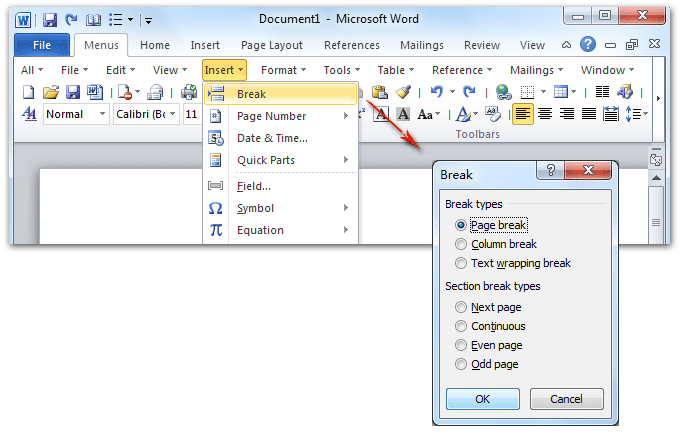

If you prefer to use keyboard shortcuts, hold down the CTRL key and hit Enter and Word will insert a Page Break for you. You can also insert Page Breaks, Column Breaks, and Text Wrapping from the Breaks button in the Page Setup section of the Layout tab. The first is from the Insert tab on Word’s ribbon, in the Pages section.
#How to do insert page break in word how to#
There are two main ways to insert a Page Break. Need different formatting and layout in your Word document Learn how to insert a continuous section break in Word 2016 and use different formatting styles. If you want to take your formatting to the next level, here’s a little secret: we use tables to lay out graphics, which allows for ultimate control over your content. Just remember to turn off the table borders so they’re not visible. Got images or other graphical elements in your document? Use the Text Wrapping tool to format caption text for images so that the rest of your text sits neatly around it. Insert a column break to start typing in the next column without losing your formatting. Again, this can be fixed by hitting the Enter key a few times, but then your formatting goes out the window. One of the most frustrating things about using columns in Word is when you want the last line of your column moved to the first line of the adjacent column.

Using a page break will also ensure that the space between pages remains intact, whatever changes you make. Doing it this way means that any changes you make will mess up your formatting. Using page breaks, your text will retain the formatting of the previous page in your document. That works too – until you want to edit your document later. Many users, unaware of the page break feature, will simply mash the Enter key when they want to start a new page. All your text that was to the right of your cursor has now moved to the new page. Advertisement Word will add a page break to the selected location in your document. On the Insert tab, in the Pages section to the extreme left, click Page Break. Insert a page break when you want to move to the beginning of the next page in your document. In Word’s ribbon at the top, click the Insert tab. In this post we’ll explain how to use page breaks to add structure and flexibility to your Word documents. You can still insert them manually should you need this flexibility. In most cases, you can change a style instead. This is because Word Styles will automatically insert breaks where necessary, leaving your formatting unscathed and giving you better control over your document. The truth is, you seldom need to force a page break even when you need content to start on the next page before filling the previous page. Word offers a number of different breaks, including Page Breaks, Column Breaks, and Section Breaks – the most commonly used being Page Breaks. Learn all about section and page breaks in MS Word. This handy tool helps format the text in your document into clean, easy-to-read paragraphs and sections. Creating a long document in Microsoft Word Use section and page breaks to better organize your document. When you’re working on longer documents with many pages and lots of text, Microsoft Word’s Breaks feature is your best friend.


 0 kommentar(er)
0 kommentar(er)
